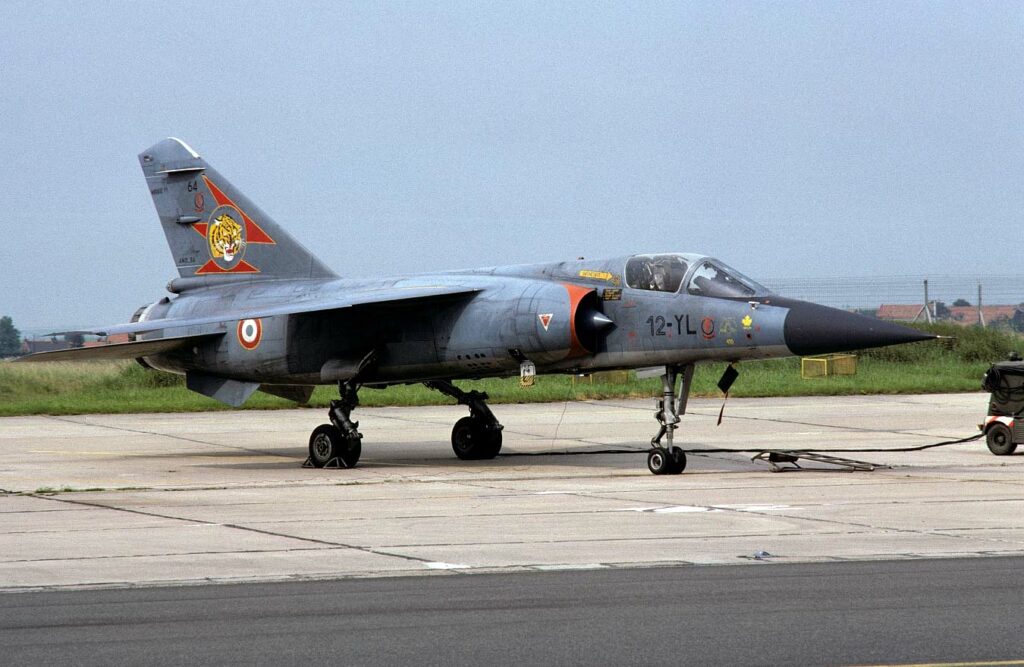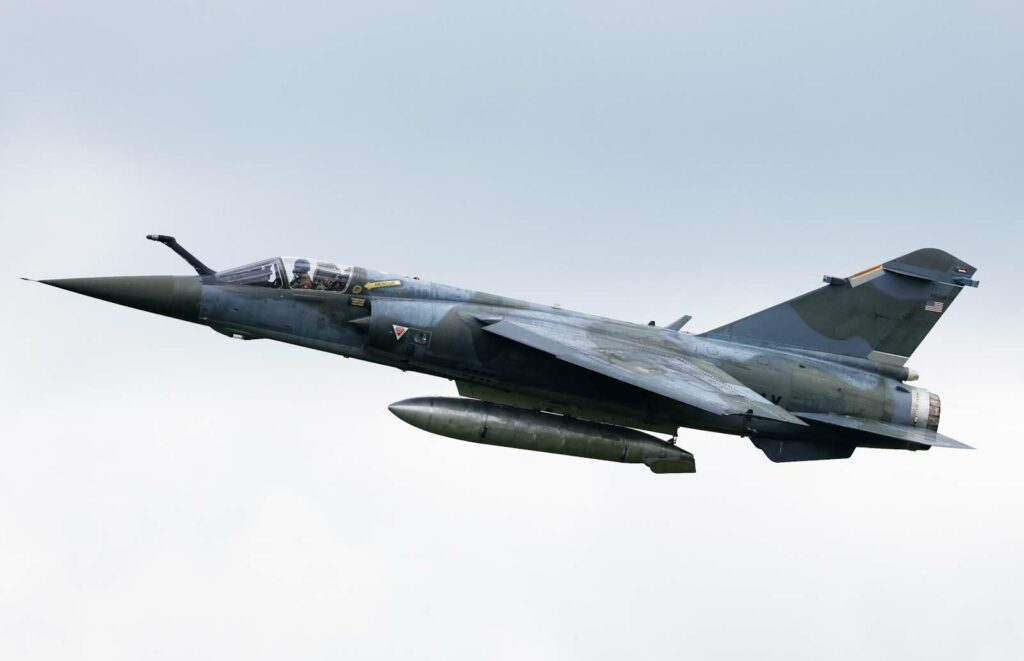The Dassault Mirage F1 is a French fighter jet known for versatility, speed, and all-weather operation capabilities.
In brief
The Dassault Mirage F1 is a departure from its delta-winged predecessors, adopting a conventional swept-wing design that allows for improved low-speed handling and shorter takeoff and landing distances. Introduced in the 1970s, it served as a multirole aircraft capable of air superiority missions, ground attack, and reconnaissance. Equipped with a single SNECMA Atar 9K-50 engine, it boasts a maximum speed of over Mach 2.2, with an operational range exceeding 1,300 miles. Its armament includes a combination of cannons, air-to-air missiles, and various bombs and rockets, making it a formidable aircraft in a variety of combat scenarios.

The Dassault Mirage F1
The development of the Dassault Mirage F1 marks a significant period in aviation history, responding to the evolving needs of modern warfare. In the late 1960s, Dassault Aviation recognized the need for a versatile aircraft that could perform a wide range of missions, from air superiority to ground attack, in all types of weather conditions. This led to the launch of the Mirage F1 program, aiming to create an aircraft that could exceed the performance of its predecessors and meet the diverse requirements of the French Air Force and potential foreign clients.
The Mirage F1 first took to the skies on December 23, 1966, showcasing its capabilities and setting the stage for its future as a key player in global air forces. Unlike its delta-winged relatives, the Mirage F1 featured a traditional swept-wing design, which contributed significantly to its all-weather operation capabilities and versatility in various roles.
Design of the Dassault Mirage F1
The design of the Mirage F1 represents a significant evolution in the Mirage family, incorporating a swept-wing rather than the delta-wing configuration of earlier models. This design choice was driven by the need for better low-speed handling characteristics and shorter runway requirements. The aircraft measures 15.03 meters in length, with a wingspan of 8.40 meters, and a height of 4.50 meters. It is powered by a single SNECMA Atar 9K-50 turbojet engine, capable of producing a thrust of 7,000 kgf, propelling the aircraft to speeds in excess of Mach 2.2.
One of the notable advantages of the Mirage F1 is its advanced avionics suite, which includes radar, navigation, and weapon systems that enable it to engage targets effectively under various conditions. However, the reliance on a single engine, while sufficient for its designed roles, could be seen as a drawback compared to some twin-engine competitors, potentially impacting survivability in hostile environments.
Performance of the Dassault Mirage F1
The performance of the Mirage F1 is characterized by its impressive speed and agility. Capable of reaching a maximum speed of Mach 2.2 (approximately 2,338 km/h or 1,453 mph) and an operational ceiling of 20,000 meters (65,617 feet), it demonstrates superior performance metrics that make it competitive with other aircraft of its era. Its range of over 2,100 kilometers (1,303 miles) when equipped with external fuel tanks, along with its ability to carry a wide range of weaponry, including air-to-air missiles, air-to-ground ordnance, and an internal cannon, makes it a versatile asset in both air superiority and ground attack missions.
Variants of the Dassault Mirage F1
The Mirage F1 has been developed into several variants to suit different roles and customer requirements. The initial production model, the Mirage F1C, was primarily an air superiority fighter. The Mirage F1CR and F1CT variants were developed for reconnaissance and ground attack roles, respectively, featuring enhanced avionics and weapon systems for these missions. The export versions, such as the Mirage F1E, offered improvements tailored to the specific needs of foreign air forces.

Military Use and Combat of the Dassault Mirage F1
The Mirage F1 has seen extensive military use by various countries around the globe. Its combat debut highlighted its capabilities in numerous conflicts, including the Iran-Iraq War, where it was used for both air-to-air combat and ground attack missions. Its versatility and robust performance have made it a valuable asset in operations across diverse environments, from the deserts of the Middle East to the mountains of the Balkans.
In the Iran-Iraq War
During the Iran-Iraq War (1980-1988), the Mirage F1 played a significant role, particularly in the Iraqi Air Force. Iraq employed the Mirage F1EQ variant, which was specifically tailored with advanced avionics, better navigation systems, and the capability to deliver a range of munitions, making it ideal for the multifaceted nature of the conflict. The Mirage F1s were engaged in some of the most intense air-to-air battles of the war, coming into direct confrontation with Iranian F-14 Tomcats and F-4 Phantom II fighters. The aircraft’s agility and the skill of Iraqi pilots led to several confirmed kills against Iranian aircraft, proving the Mirage F1’s effectiveness in air superiority roles.
Moreover, the Mirage F1 showcased its ground attack capabilities by conducting strikes against Iranian troop concentrations, fortifications, and oil facilities, utilizing its capacity to carry a diverse array of ordnance, from laser-guided bombs to conventional drop bombs and rockets. This dual-role capability was invaluable for Iraq, allowing for strategic flexibility and the ability to respond rapidly to changing battlefield conditions.
Operations Across Diverse Environments
The Mirage F1’s operational history extends beyond the Middle East. Its deployment in the Balkans, for instance, highlighted its adaptability to different geographic and climatic conditions. The aircraft operated in areas with varying terrain, from the rugged mountains to the coastal regions, demonstrating its navigational precision and ability to execute missions under challenging conditions.
Contribution to Military Operations Worldwide
The Mirage F1’s service record spans several continents and includes operations by various countries. Apart from Iraq and France, countries like Spain, South Africa, and Libya have utilized the Mirage F1 in various capacities, from defending airspace sovereignty to conducting reconnaissance and offensive operations.
- Spain used its Mirage F1s for air defense and patrol missions, valuing the aircraft for its speed and endurance.
- South Africa employed the Mirage F1CZ and F1AZ variants during the Border War in Southern Africa, where it conducted both air interception and ground-attack missions, particularly excelling in the latter role due to its robust design and effective weapons delivery systems.
- Libya‘s Mirage F1s were involved in border conflicts and engaged in skirmishes with neighboring countries, demonstrating their utility in North African combat scenarios.
These diverse operational theaters underscore the aircraft’s ability to perform under a wide range of conditions, from high-altitude engagements to low-level strike missions. The Mirage F1’s design facilitated operations in hot, arid climates as well as in colder, more temperate regions, proving the aircraft’s reliability and effectiveness across the globe.
Throughout its service life, the Mirage F1 competed with aircraft such as the American F-4 Phantom and the Soviet MiG-23. Its sales to countries like Iraq, Spain, and South Africa underscore its appeal as a multirole fighter. While some air forces have phased out the Mirage F1 in favor of more modern aircraft, it remains in service in a limited capacity, testament to its enduring capabilities and historical significance.
–
The Dassault Mirage F1 stands as a key figure in military aviation history, embodying the transition towards versatile, multirole fighter aircraft capable of excelling in a variety of missions. Its development and operational use have demonstrated the importance of adaptability and performance in responding to the changing dynamics of air combat. As it gradually retires from active service, the Mirage F1 leaves behind a legacy of technological innovation and combat effectiveness that continues to influence modern air force strategies and aircraft design principles.
Back to the Fighter Jet section.